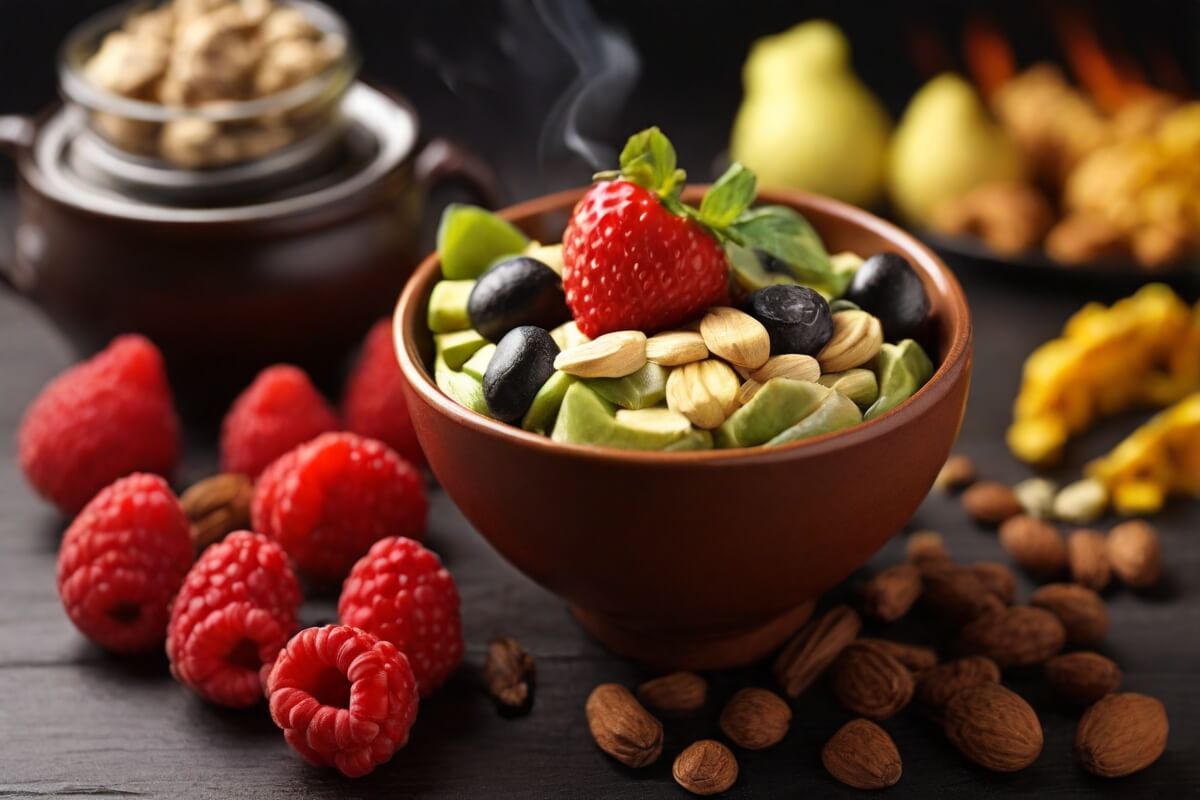Do you want to lose weight and improve your health? If so, you might be interested in learning about thermogenic foods.
These are foods that increase your metabolism, the rate at which your body burns calories, by generating heat and stimulating the fat-burning process. By eating more of these foods, you can boost your energy levels, curb your appetite, and shed excess pounds.
In this article, we will explain what thermogenesis is, how it works, and what are some of the best thermogenic foods to include in your diet. We will also give you some tips on how to optimize your thermogenic effect and avoid potential side effects. Read on to discover how you can use thermogenic foods to speed up your metabolism and burn fat.
What is thermogenesis and how does it work?
Thermogenesis is the process of heat production in the body. It is influenced by several factors, such as your age, gender, body composition, activity level, hormonal balance, and environmental temperature. However, one of the most important factors that affect thermogenesis is your diet.
When you eat food, your body needs to use energy to digest, absorb, and metabolize it. This energy expenditure is called the thermic effect of food (TEF), or diet-induced thermogenesis (DIT). Depending on the type and amount of food you eat, your TEF can vary from 5% to 30% of your total calorie intake1.
Some foods have a higher TEF than others, meaning they require more energy to be processed and utilized by the body. These foods are called thermogenic foods, and they can increase your metabolism and calorie burning for several hours after you eat them. Thermogenic foods can also affect your appetite hormones, such as ghrelin and leptin, and make you feel more satisfied and less hungry2.
What are some of the best thermogenic foods to try?

There are many foods that can have a thermogenic effect, but some are more effective than others. Here are nine of the best thermogenic foods to speed up your metabolism and burn fat:
1. Lean protein
Protein is the most thermogenic macronutrient, meaning it has the highest TEF among carbohydrates, fats, and alcohol. Protein can increase your metabolism by 15% to 30%, compared to 5% to 10% for carbohydrates and 0% to 3% for fats1. Protein can also help you build and maintain muscle mass, which is metabolically active and burns calories even at rest3.
Some of the best sources of lean protein are eggs, chicken, turkey, fish, lean beef, low-fat dairy, tofu, and whey protein powder. You should aim to consume at least 0.8 grams of protein per kilogram of body weight per day, or more if you are physically active or trying to lose weight4.
2. Chili peppers
Chili peppers are spicy vegetables that contain a compound called capsaicin, which is responsible for their heat and pungency. Capsaicin can boost your metabolism by activating the receptors that regulate your body temperature and triggering a process called non-shivering thermogenesis5. Capsaicin can also suppress your appetite and reduce your food intake.
You can add chili peppers to your dishes, such as soups, stews, curries, salads, and sauces, or take them as a supplement. However, be careful not to consume too much, as capsaicin can cause stomach irritation, heartburn, and diarrhea in some people.
3. Green tea
Green tea is a popular beverage that has many health benefits, such as antioxidant, anti-inflammatory, and anticancer properties. Green tea can also increase your metabolism and fat burning, thanks to its high content of catechins, which are a type of polyphenol. Catechins can enhance the activity of an enzyme that breaks down fat and stimulates the release of noradrenaline, a hormone that boosts thermogenesis.
Green tea also contains caffeine, which can further increase your metabolism and energy expenditure. However, the effects of green tea and caffeine may vary depending on your genetic makeup, body weight, and tolerance. To get the most benefits from green tea, you should drink at least three to four cups per day, preferably before meals or exercise.
4. Coffee
Coffee is another popular beverage that can boost your metabolism and fat burning, thanks to its caffeine content. Caffeine can stimulate your central nervous system and increase your heart rate, blood pressure, and oxygen consumption. Caffeine can also enhance the breakdown of fat and the release of fatty acids into the bloodstream, making them available for energy production.
However, the effects of caffeine may diminish over time, as your body develops tolerance and adapts to its stimulant action. Therefore, you should limit your intake of coffee to no more than four cups per day, and avoid drinking it late in the day, as it can interfere with your sleep quality and recovery.
5. Cacao
Cacao is the raw form of chocolate, and it is rich in antioxidants, minerals, and phytochemicals that can benefit your health and mood. Cacao can also increase your metabolism and fat burning, thanks to its content of theobromine, which is a methylxanthine similar to caffeine. Theobromine can stimulate your nervous system and increase your energy expenditure and lipolysis, the breakdown of fat.
Cacao also contains flavanols, which are a type of flavonoid that can improve your blood flow and oxygen delivery to your muscles and organs, enhancing their metabolic function. To enjoy the benefits of cacao, you can consume it as dark chocolate (at least 70% cacao), cacao nibs, cacao powder, or cacao butter. However, be mindful of the calories and sugar content, and limit your intake to no more than one ounce per day.
6. Turmeric
Turmeric is a spice that gives curry its yellow color and distinctive flavor. Turmeric has been used for centuries in traditional medicine for its anti-inflammatory, antibacterial, and antiviral properties. Turmeric can also increase your metabolism and fat burning, thanks to its main active ingredient, curcumin. Curcumin can modulate the expression of genes and proteins involved in thermogenesis, such as uncoupling protein 1 (UCP1), which dissipates energy as heat.
Curcumin can also inhibit the formation of new fat cells and promote the browning of white fat, which is the type of fat that stores energy, into brown fat, which is the type of fat that burns energy. To get the most benefits from turmeric, you should consume it with black pepper, which contains piperine, a compound that enhances the absorption and bioavailability of curcumin.
7. Leafy greens
Leafy greens are vegetables that have large, edible leaves, such as spinach, kale, lettuce, arugula, and cabbage. Leafy greens are low in calories and high in fiber, vitamins, minerals, and antioxidants, making them an essential part of a healthy diet. Leafy greens can also increase your metabolism and fat burning, thanks to their high content of nitrates, which are compounds that are converted into nitric oxide in the body. Nitric oxide can relax and widen your blood vessels, improving your blood flow and oxygen delivery to your tissues, and enhancing their metabolic function.
Leafy greens can also increase your levels of glucagon-like peptide-1 (GLP-1), a hormone that stimulates insulin secretion, reduces appetite, and increases thermogenesis. To get the most benefits from leafy greens, you should eat them raw or lightly cooked, as heat can destroy some of their nutrients and nitrates.
8. Healthy fats and omega-3 fatty acids
Fats are often considered the enemy of weight loss, but not all fats are created equal. Some fats, such as monounsaturated and polyunsaturated fats, can actually help you lose weight and improve your health, by lowering your cholesterol, blood pressure, and inflammation. Healthy fats can also increase your metabolism and fat burning, by stimulating the production of hormones that regulate your appetite, such as leptin and cholecystokinin (CCK).
Some of the best sources of healthy fats are olive oil, avocado, nuts, seeds, and fatty fish. Fatty fish, such as salmon, tuna, mackerel, and sardines, are particularly beneficial, as they contain omega-3 fatty acids, which are a type of polyunsaturated fat that can enhance thermogenesis and fat oxidation, especially in combination with exercise. You should aim to consume at least two servings of fatty fish per week, or take a fish oil supplement if you are vegetarian or vegan.
9. Apple cider vinegar
Apple cider vinegar is a fermented product made from apples and yeast. It has been used for centuries as a natural remedy for various conditions, such as diabetes, high cholesterol and infections. More recently, research has shown that apple cider vinegar can have some real health benefits, such as helping to reduce blood sugar levels and aiding weight loss.
Apple cider vinegar contains acetic acid, which is the main active compound in vinegar and may be responsible for its beneficial effects. Acetic acid can increase your metabolism and fat burning by generating heat and stimulating the process of lipolysis, which is the breakdown of fat. Acetic acid can also affect your appetite hormones, such as ghrelin and leptin, and make you feel fuller and less hungry12.
You can consume apple cider vinegar as a liquid, by diluting one or two tablespoons in a glass of water, or as a supplement, in the form of capsules, powders or gummies. However, you should be careful with the dosage and quality, as they may contain additives, contaminants or inaccurate amounts of the active ingredient. Apple cider vinegar can also interact with some medications, such as anticoagulants, antidepressants or diabetes medications, and cause adverse effects such as nausea, heartburn or diarrhea in some people. Therefore, you should consult your doctor before taking any supplement, and follow the instructions on the label.
How to optimize your thermogenic effect and avoid potential side effects?

Eating thermogenic foods can help you speed up your metabolism and burn fat, but there are some things you should keep in mind to optimize your results and avoid potential side effects. Here are some tips to follow:
- Balance your diet: Thermogenic foods are not magic bullets that can make you lose weight on their own. You still need to eat a balanced and nutritious diet that meets your calorie and macronutrient needs, and includes a variety of foods from all food groups. Thermogenic foods should be used as a complement, not a substitute, for a healthy diet.
- Drink plenty of water: Water is essential for your health and metabolism, as it helps transport nutrients and oxygen to your cells, flush out toxins and waste products, and regulate your body temperature. Water can also increase your TEF, as your body needs to use energy to heat it up to your core temperature. You should drink at least eight glasses of water per day, or more if you exercise or sweat a lot.
- Exercise regularly: Exercise is another key factor that can boost your metabolism and fat burning, by increasing your muscle mass, oxygen consumption, and calorie expenditure. Exercise can also enhance the effects of thermogenic foods, by increasing your blood flow and fat mobilization. You should aim to do at least 150 minutes of moderate-intensity aerobic exercise, such as brisk walking, jogging, cycling, or swimming, and two or three sessions of strength training, such as lifting weights, doing push-ups, or using resistance bands, per week.
- Be careful with supplements: While some thermogenic foods are available as supplements, such as capsaicin, green tea extract, or caffeine pills, you should be careful with their dosage and quality, as they may contain additives, contaminants, or inaccurate amounts of the active ingredients. Supplements can also interact with some medications, such as blood thinners, antidepressants, or diabetes drugs, and cause adverse effects, such as nausea, jitteriness, insomnia, or palpitations. Therefore, you should consult your doctor before taking any supplements, and follow the instructions on the label.
- Listen to your body: Thermogenic foods can have different effects on different people, depending on their genetics, metabolism, and tolerance. Some people may experience more benefits than others, while some may experience more side effects than others. Therefore, you should listen to your body and adjust your intake of thermogenic foods accordingly. If you feel any discomfort, such as stomach pain, headache, or dizziness, you should reduce or stop your consumption of thermogenic foods, and seek medical attention if the symptoms persist or worsen.
Conclusion
Thermogenic foods are foods that increase your metabolism and fat burning, by generating heat and stimulating the fat-burning process.
By eating more of these foods, you can boost your energy levels, curb your appetite, and shed excess pounds. Some of the best thermogenic foods to try are lean protein, chili peppers, green tea, coffee, cacao, turmeric, leafy greens, healthy fats, and apple cider vinegar.
However, you should also balance your diet, drink plenty of water, exercise regularly, be careful with supplements, and listen to your body, to optimize your thermogenic effect and avoid potential side effects.
We hope you enjoyed this article and learned something new about thermogenic foods. If you have any questions, comments, or suggestions, please feel free to leave them below. We would love to hear from you and help you achieve your health and fitness goals. Thank you for reading and have a great day!
We hope this article has been useful and informative for you. Leave your comment below and follow us on facebook and pinterest for more tips
